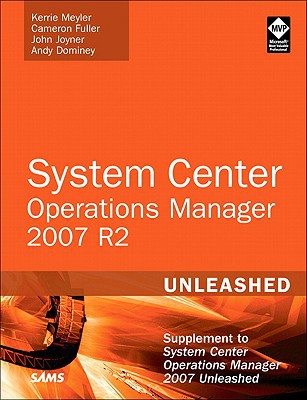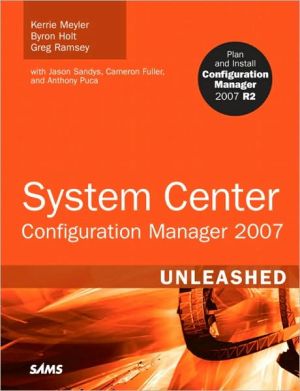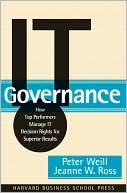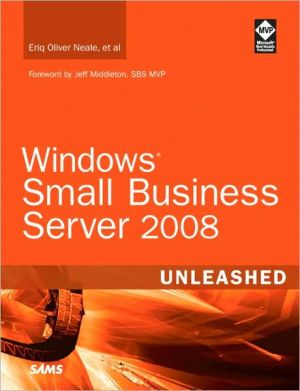System Center Operations Manager (OpsMgr) 2007 R2 Unleashed: Supplement to System Center Operations Manager 2007 Unleashed
This up-to-the-minute supplement to System Center Operations Manager 2007 Unleashed brings together practical, in-depth information about System Operations Manager 2007, including major enhancements introduced with the R2 release, as well as essential information on other products and technologies OpsMgr integrates with and relies upon.\ Drawing on their unsurpassed deployment experience, four leading independent OpsMgr experts with a half dozen leading subject matter experts show how to take...
Search in google:
This up-to-the-minute supplement to System Center Operations Manager 2007 Unleashed brings together practical, in-depth information about System Operations Manager 2007, including major enhancements introduced with the R2 release, as well as essential information on other products and technologies OpsMgr integrates with and relies upon.Drawing on their unsurpassed deployment experience, four leading independent OpsMgr experts with a half dozen leading subject matter experts show how to take full advantage of new Unix/Linux cross platform extensions, Windows Server 2008 and SQL Server 2008 integration, PowerShell extensions, and much more. They also present in-depth coverage of using OpsMgr with virtualization, authoring new management packs, and maximizing availability.A detailed “OpsMgr R2 by Example” appendix presents indispensable tuning and configuration tips for several of OpsMgr R2’s most important management packs. This book also contains the world’s most compre- hensive collection of OpsMgr R2 reference links. Discover and monitor Linux and Unix systems through OpsMgr with the new Cross Platform Extensions Utilize Microsoft’s upgraded management packs and templates for monitoring operating systems, services, and applications Monitor your system with the Health Explorer and new Visio add-in Create OpsMgr 2007 R2 reports and queries utilizing SQL Server 2008 Understand how Windows Server 2008 and OpsMgr integrate Use PowerShell and the OpsMgr Shell to automate common management tasks Efficiently manage virtualized environments (Hyper-V or ESX vCenter) Author your own OpsMgr custom management packs Implement advanced high availability and business continuity management Use targeting to apply the appropriate monitoring to each component Master advanced ACS techniques for noise filtering, access hardening, and auditing
Chapter 1 Introduction and What’s New 1Licensing Updates 2Licensing Changes to the System Center Server Management Suite 3Licensing of Cross Platform Applications 4New in Service Pack 1 4SP 1 Highlights 4Gateway Enhancements 5Clustered RMS Enhancements 6RMS Encryption Key Backup 6R2 Highlights and Capabilities 7Importing Management Packs 9New and Updated Templates 11User Interface 13Run As 14IIS 7 and ASP.NET 64-Bit Apps 14Large-Scale Monitoring of URLs 15Maintenance Mode 1532-Bit Performance Counter Support on 64-Bit Systems 15Web Console (Health Explorer) 15Notification Subscription Wizard 16Service Level Monitoring 17Reporting Enhancements 19Recalculating and Resetting Monitor States 21Power Consumption Monitoring 22Summary 22Chapter 2Unix/Linux Management: Cross Platform Extensions 23Supported Platforms and Requirements 23Preparing to Discover Unix/Linux Computers 27Name Resolution 28Account Information Gathering 28Update WinRM 29Configuring Accounts and Profiles 30Importing the Unix/Linux Management Packs 36Discovering and Monitoring Unix/Linux Computers 39Discovering 39Manually Installing the CrossPlat Agent 45Notes on Unix Commands 48Common Agent Deployment Errors 50Additional Reference Material on CrossPlat 51Monitoring (Where Do You Find Everything?) 53Integrating Unix/Linux Computers in OpsMgr 54OpsMgr Console 54Health Explorer 56Reports 57Tasks 58Integration with Distributed Applications 59Bridgeways Management Packs 61The Bridgeways VMware ESX Management Pack 62The Bridgeways Apache Management Pack 68Novell SUSE Management Pack 70Logical Disk Volume Recovery 72Cron Service Recovery 73Performance Collection 76Custom Scripting in the SUSE Management Pack 77Management Pack Templates 83Unix/Linux Log File Template 83Unix/Linux Service Template 84Connectors 86Summary 96Chapter 3Operations Manager 2007 R2 and Windows Server 2008 97Installing Operations Manager 2007 R2 97Hotfixes 98Prerequisite Changes 99Roles and Features 99The Windows 2008 Firewall 103After Installation 106Upgrading to Operations Manager 2007 R2 109Upgrading to OpsMgr 2007 R2–Currently on Windows 2008 109Upgrading to OpsMgr 2007 R2–Currently on Windows 2003 111Upgrading to OpsMgr 2007 R2–Known Issues 111Additional Windows 2008 Considerations 112Windows Server 2008 SP 2 112Windows Server 2008 R2 112Server Core 113Windows Server 2008 Updated or New Management Packs 114Summary 116Chapter 4Using SQL Server 2008 in OpsMgr 2007 R2 117Core OpsMgr Component Support 117High Availability with Standard and Enterprise Editions 119Database Maintenance with Standard and Enterprise Editions 120Setup 121Hardware Best Practices 121Upgrading Databases from SQL Server 2005 to SQL Server 2008 123SQL 2008 Reporting Services 128Post-Installation Steps for SQL Server 131Operations Manager 2007 R2 Reporting 133Architecture 133Enhancements 135Database Maintenance 138Operational Database Maintenance 139Data Warehouse Maintenance 144Useful SQL Queries 145Operational Database SQL Queries 146Data Warehouse Database SQL Queries 148Miscellaneous SQL Queries 149Summary 151Chapter 5PowerShell Extensions for Operations Manager 2007 153Windows PowerShell Basics 153Installing and Accessing PowerShell 154General PowerShell Concepts 155Basic Navigation and Functionality 157Cmdlet Structure 157Getting Started 159Special Variable $_ 161Comparison Operators 162Filtering Cmdlets 162Sorting and Selecting Cmdlets 165Formatting Cmdlets 166Conditional Statements 167Looping Statements 170Providers 171Profiles 172Using the Operations Manager PowerShell Shell 173Monitoring:\\ Provider 174Listing OpsMgr Shell Cmdlets 175Commonly Used Cmdlets 175Get-Alert and Monitoring:\\ 177Incorporating the Operations Manager SDK 179PowerShell Performance 180PowerShell and Operations Manager Examples 181General PowerShell Examples 181Operations Manager Examples 184PowerShell Best Practices 191Summary 191Chapter 6Management Solutions for Small and Midsize Business 193Windows Small Business Server 2008 194SBS 2008 Native Management Features 194Remote Operations Manager Scenarios for SBS 2008 197Windows Essential Business Server 2008 198EBS and Essentials 198EBS with Remote OpsMgr 200Preview of System Center Essentials 2010 202Essentials 2010 Setup Experience 203Using the Essentials 2010 Virtualization Features 205Other New Essentials 2010 Features 208Summary 211Chapter 7Operations Manager and Virtualization 213The Case for VM Management 213Virtualization Challenges and Rewards 214VM Management Standards: Cloud Computing Enabler 215Managing VMs without VMM 216Choosing Not to Deploy Virtual Machine Manager 217Monitoring Virtual Server 218Monitoring Windows Server Hyper-V 219Monitoring VMware ESX with OpsMgr 220Installing VMM and Connecting It to OpsMgr 221Installing Virtual Machine Manager 222Integrating Operations Manager with VMM 225The VMM Management Pack 227ESX vCenter Integration 232Adding a VMware Virtualization Manager 232Managing ESX Hosts and Guest VMs 234Performance and Resource Optimization 236Enabling PRO Tips 236VMM Native CPU and Memory PRO Feature 237PRO-Enabled Vendor Management Packs 239Using VMM in DMZs and Untrusted Domains 240OpsMgr and VMM Agent Alternate Security Modes 240VMM and OpsMgr Agent Architecture Differences 243Virtualizing OpsMgr 2007 and VMM Components 244Summary 246Chapter 8Management Pack Authoring 247What’s in a Management Pack? 248MP Authoring Tools 248The Authoring Console 249The Operations Console 249AnA Script Editor 250Scripting in OpsMgr 2007 251Preparing Your Development Workstation 251Types of Scripts in OpsMgr 2007 Management Packs 252Nuts and Bolts of the OpsMgr Scripting API 253Logging an Event 254Scripting for Health Monitoring and Displaying Performance 255Using a Script in Discovery 256Designing Your Management Pack 259Identifying Application Components (Classes) 260How the Components Are Related (Relationships) 260Defining the Health Model (Health Rollup) 261Design Best Practices 262Design Worst Practices (AKA Good Stuff NOT to Do) 262Discovering Application Components 262Discovery Best Practices 264Discovery Worst Practices 264Building Your Management Pack 264The Point-of-Sale Batch Processing Application 265Naming Conventions 265Classes and Relationships 267Service and Health Model in the POS Batch Processing Application 268Using the R2 Authoring Console to Create Object Classes and Relationships 269Creating the Object Classes and Relationships 270Object Discoveries 272Monitoring 277Product Knowledge 280Modules: The Building Blocks of Workflows 280Data Source 281Condition Detection 281Write Action 281Probe Action 281Workflow Summary 282Advanced Authoring: Creating a Custom Workflow 283Step-by-Step: Creating a Custom Workflow with Cook Down 284Create the Custom Data Source 285Create the Monitor Type 286Create the Custom Unit Monitor 289Create the Performance Collection Rule 290Create a Performance View 292Verifying Cook Down 296Troubleshooting Cook Down 298Reports 303Tips for a Successful MP Authoring Experience 305Summary 305Chapter 9Unleashing Operations Manager 2007 307Distributed Environments 307Explaining Distributed Environments 307Distributing Management Servers and Gateways 309Agent Deployment and Management 314Remote Operations 317High Availability 320Clustering the OpsMgr Components 321Root Management Server High Availability 323Advanced Cluster Configurations 325Clustering Alternatives 326Business Continuity 327Backup and Recovery 328SQL Log Shipping and Database Mirroring 332Visio Add-In for OpsMgr 2007 332Beyond the Basics of ACS 338ACS in OpsMgr 2007 R2 338ACS Noise Filtering 340ACS Access Hardening 341Auditing SQL Server 2008 344Auditing Cross Platform 347Secure Site Log Replay 348Community Resources 349Network Monitoring Using Distributed Applications 350Monitoring Redundant LAN Links 350Using the Distributed Application Designer 351Targeting 356Objects in OpsMgr 2007 356What You Can Target 358Using Management Pack Templates 366Using the Authoring Console to Create a Target 371Summary 389Appendix AOpsMgr R2 by Example 391Active Directory MP 391How to Install the Active Directory MP 391Tuning/Alerts to Look for in the Active Directory MP 394Active Directory Management Pack Evolution 407Exchange 2007 MP 407How to Install the Exchange 2007 MP 408Exchange MP Tuning/Alerts to Look for 409SQL Server MP 410How to Install the SQL Server MP 410SQL MP Optional Configuration 411SQL MP Tuning/Alerts to Look for 411SQL Server Management Pack Evolution 415Windows Server MP 416How to Install the Windows Server MP 416Windows Server MP Tuning/Alerts to Look for 417Windows Server Management Pack Evolution 420Operations Manager MP 420How to Install the Operations Manager MP 420Operations Manager MP Tuning/Alerts to Look for 420DNS MP 427How to Install the DNS MP 427DNS MP Tuning/Alerts to Look for 428DNS Management Pack Evolution 433Group Policy MP 433How to Install the Group Policy MP 433Group Policy MP Tuning/Alerts to Look for 434Group Policy Management Pack Evolution 436DHCP MP 436How to Install the DHCP MP 436DHCP MP Tuning/Alerts to Look for 437DHCP Management Pack Evolution 439Print Server MP 439How to Install the Windows Print Server MP 439Windows Print Server MP Tuning/Alerts to Look for 440Print Server Management Pack Evolution 440SharePoint MP 441How to Install the SharePoint MP 441SharePoint MP Tuning/Alerts to Look for 441Configuration Manager MP 443How to Install the Configuration Manager MP 443How to Configure the Configuration Manager MP 444Configuration Management MP Tuning/Alerts to Look for 447TMG MP 447How to Install the TMG MP 447How to Configure the TMG MP 448TMG MP Tuning/Alerts to Look for 453Appendix BReference URLs 455General Resources 455Microsoft’s OpsMgr Resources 464Blogs 467OpsMgr Shell 469PowerShell Information 470Cross Platform 471Connectors 471The System Center Family 472Public Forums 473Appendix C Available Online 475SQL Server Resources 475Authoring Resources 476ACS Resources 476Reference URLs 477Index 479







